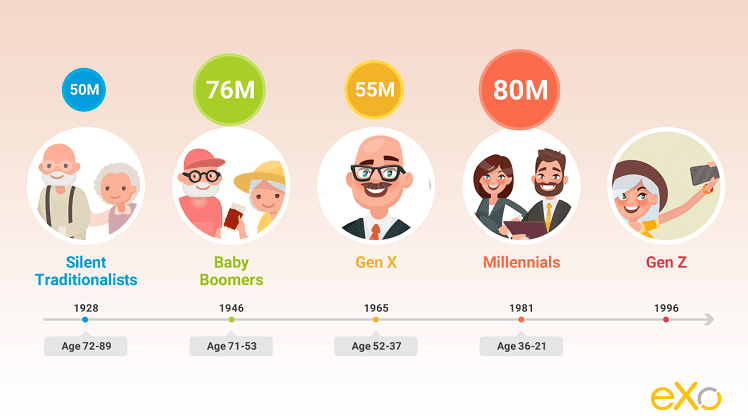“Diversity and inclusion, which are the real grounds for creativity, must remain at the center of what we do” – Marco Bizzarri
Diversity refers to the uniqueness of individuals in terms of physical appearance, nationality, ethnic background, religion, gender, age gap, educational qualification, and professional experience. Workplace diversity means uniting individuals with different mindsets, opinions, perspectives, expertise, and expectations in one place. It enables individuals to think distinctively in a unifying manner simultaneously. However, generational differences in the workplace can be challenging to manage effectively. It is because if everyone used to think the same way, it would be easier to make a consensus on tricky corporate matters.
Reportedly, leaders and managers face various challenges in managing the diversity of generations in one place. If you are the one among such professionals, the blog post is going to provide you a comprehensive account of generation gaps among various individuals, the possible problems owing to differences and potential ways to deal with the challenges of generational differences in your workdplace.
So, keep reading until the end!
Generational Breakdown in th Workplace: Chronicle Categorization of the Generations

Today, companies are appointing people of different age groups without keeping the differences into consideration. From seasoned professionals to fresh faces, everyone is working to bring the bacon home. Therefore, generational diversity is increasing significantly. Let’s have a view of all generation present in the world as well as in the corporate sector presently:
1. Traditionalists:
The generation includes the people born from 1928 to 1945. They are considered suitable for face-to-face collaboration within the workplace. The people falling in this category are the most loyal employees of the organizations.
2. Baby Boomers:
The generation includes the people who born in 1946 and 1964. They are considered reliable in professional accomplishments and corporate ethics. However, they are somehow reserved in nature during socialization. The people falling in this category are most hardworking and dedicated to their professions.
3. Generation X:
It comprised the people born from 1965 to 1989, having relatively more exposure to modern tools and techniques. The generation is also called the middle child because it between the baby boomers and Millennials. Around 50% of Gen-X is aware of technology.
4. Generation Y:
It is referred to the people born from 1981 to 1996. It comprised the largest workforce in the public and private sectors. The Millennials are expected to hold more than three-quarters of the workforce globally by the year 2025. They are innovative in their mentality with startup intentions.
5. Generation Z:
The generation comprised of the people born in 1997- 2015. It consists of the youngest people in the present-day workplaces. The people belong to the current era of wireless connectivity and social media. These are known as the true natives of the digital age.
Generational Issues in the Workplace
The companies that successfully utilized the distinctiveness of the people are thriving smoothly in the business world. However, it requires building a harmonious whole at the workplace – a hard nut to crack. It is because every generation has unique personality traits and expectations which pose challenges to the organizations.
Consider the below issues that every company has to deal with while incorporating different generations at the same place:
- The probability of conflicts is higher, owing to the difference between norms and values.
- The contrast of communication styles can lead to clashing and arguments.
- Interpersonal issues can arise while managing the teams comprising different generations.
- Lack of understanding can lead to low collaboration and decreased productivity.
- The problems of stereotyping are one of the most significant challenges for the companies.
- The problems of coordination are bigger, owing to a difference in thinking and perception.
- Baby boomers want long working hours while generation Y and Z need work flexibility.
- A significant gap in communication leads to a divide among the employees.
- The difference in thinking patterns leads to challenges for leadership.
- Ageism poses a severe threat of assumptions and language barriers.
Benefits of Generational Diversity in the Workplace
Over the years, many generations have emerged on the landscape of the public and private sectors. Despite the challenges, it has helped the organizations to bring out the best from diversity by all means. Here’s why.
- Employees belonging to different generations contribute to the organizations with their unique thinking patterns.
- The individuals of different generations have vital soft skills that are crucial for achieving corporate goals.
- Different generations view problems diversely that lead to an effective system of resolving the potential issues and problems in the workplace.
- Diversity in the workplace helps the companies to spur innovation through a variety of motivating ideas and deployment plans.
- Hosting people from different generations encourage rigorous learning opportunities to engage everyone in the common organizational goals.
- Generational differences in the workplace help in understanding the uniqueness of different targeted audiences based on age gaps.
- The multigenerational workforce ensures a perfect environment for corporate training and comprehensive mentoring for skills grooming.
- The differences in generations help companies understand the expectations of different clients and business investors for higher ROI.
- The amalgamation of generation diversity in the workplace is significantly helpful in facilitating tech-driven workplaces.
- Diversity at the workplace helps to attract talent, which is the most crucial factor of business success.
Top 7 Tips for Managing Generational Differences in the Workplace

The ageism and experiences of different generations shape the workplaces in various ways, both positive and negative. It depends on the companies on how they value and manage the generational differences. The best way is to keep the benefits in focus while dealing with the challenges.
Deep down in the heart, everyone wants to perform well at the workplace, but generational differences can be the barriers in the way of employees. So, it is essential to manage diversity at the workplace to provide an ideal atmosphere for improved performance and professional growth.
Want to know the best practices for mitigating problems and managing generational differences in the workplace? Here are given a few ways to help you empower the workforce in a collaborative environment:
1. Define proper strategies for recruitment
Most of the companies face higher disparity in generational differences owing to inconsistent recruitment policies. For example, hiring fresh graduates can always lead to a higher concentration of in-experience people or modern generations in the organization. It has been observed that such strategies can result in higher conflicts in the organization. Consider the below:
- Define a ratio for equal opportunities in talent acquisition.
- Maintain a balance of generation in the workplace.
- Create equal opportunities for all in the succession plans.
- Define a comprehensive on-boarding process in the workplace.
2. Ensure active listening for collaboration
The managers and people in leadership roles should not solely rely on silent observation. It is because observing the behaviors without discussions can lead to false assumptions. For example, senior employees don’t hate technology in all cases, as many of them are very adaptive in nature. So, fostering a culture of active listening can help in managing generational differences in the workplace. Consider the below tips:
- Conduct one-to-one meetings for communication in person.
- Focus more on group discussions and general talk sessions.
- Consider the mental health aspects of the employees in the workplace.
- Conduct feedback sessions for improvement in work affairs.
3. Avoid stereotyping and false assumption
Age-based hypothesis and stereotyping can be dangerous for the organization. The primary reason is that every generation comes up with certain capabilities that are beneficial for the company. For example, the youth has fresh ideas, while the old generations ensure the validity of the ideas based on experience. So, follow the given:
- Ensure that recruitment is made justly to avoid prejudice.
- Integrate personality assessment in the on-boarding process.
- Foster active discussion to reveal thinking perspectives.
- Maintain a friendly workplace environment for all and sundry.
4. Focus on effective communication styles
The manager and leaders should have comprehensive knowledge of their conversational styles to keep everyone at the workplace on the same page of clarity and trust. Therefore, higher authorities and managers should learn the skills of business communication to ensure generational diversity management. Here are the tips for effective communication:
- Adopt an assertive way of conversation for mutual understanding
- Focus on verbal and non-verbal communication in the workplace
- Tone down your ways and selection of words in an enthusiastic manner
- Listen up first and then choose the best method for response
5. Adopt a suitable leadership style
Leading across the diversity of generation is not a piece of cake. It is evident from the fact that people in leadership positions should consider individual distinctiveness for managing the teams. In this regard, the selection of appropriate styles for leading the workforce belonging to different generations is essential for success. The individuals holding key roles in the companies should not be the leaders with an inadequate vision for difference management. So, follow the given below:
- Understand different leadership styles to pick the best.
- Nurture role-model behaviors to set a pathway.
- Ensure leadership training to lead others through vision.
- Encourage diversity using motivation and feedback.
6. Establish age-diverse teams for assignment
Effective team building can significantly help in mitigating the barriers to generational diversity management. For this purpose, companies should focus on devising multigenerational project teams for designated corporate assignments. It will not only help the employees to understand each other but also foster a culture of collaboration. Consider the tips:
- Use a customized approach for every team member
- Focus on facilitation skills for improved performance
- Deploy employee retention at micro-management levels
- Value the workforce contributions equality in the same ways
7. Ensure skills development programs
There is no surprise in considering equal participation of employees in the skills development and training programs. For example, comprehensive training of soft skills like negotiation can help the employees resolve their generational difference in the most productive manner. Companies can keep their employees on the same page of trust and understanding with the help of technical skills upgrades and interpersonal grooming. So, consider the tips:
- Identify the skills gap assessment regularly.
- Define training objectives to explain the results.
- Get assistance from experienced mentors and corporate trainers.
- Define a pattern for post-training evaluation.
Keynote: Generational Diversity is the Formula for Success
Summing up, diversity is the name of beauty in the world. It is because young generations breathe fresh air to the workplaces while the senior generations enlighten the organizations with their experience. In this way, an amalgamation of different generations in the workplace holds significant importance for the public and private sectors. However, it is not possible to get maximum benefits of diversity and inclusion with effectively managing the generational differences in the workplace.
So, business people should follow the best practices to engage the workforce from different generations to succeed. Want to stay ahead in competitive markets but not skillful in deploying organizational vision to diverse employees? Get a helping hand!
Request training experts today to achieve your diversity management goals effectively by breaking down age barriers through negotiations and mutual understanding!
Learn More:
Why Self-Awareness Training Is Crucial For Emerging Leaders
How To Improve The Commitment of Employees
How Incompetent Leaders Destroy Teams


